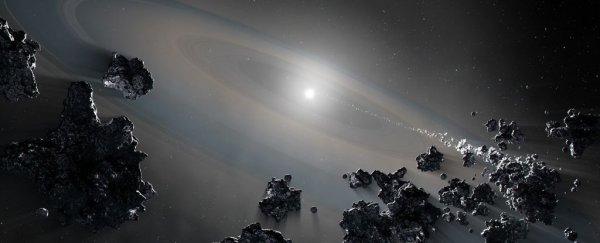When a star dies, what happens to its planets? Well, if that star is a certain white dwarf 86 light-years away, those planets are currently in the process of being torn apart and eaten by the star, like some grotesque cosmic performance of Kronos devouring his children.
This is not entirely unusual for white dwarfs. But this particular star, named G238-44, is a glutton: for the first time, astronomers have seen one of these stars swallowing material from both the inner and outer reaches of its planetary system at the same time, in the most far-reaching display of stellar filial cannibalism observed to date.
In G238-44's atmosphere, astronomers have detected traces of elements that suggest the dead star has recently accreted material that is metallic and rocky, like inner Solar System asteroids, as well as material that is icy, like the frozen bodies that can be found in the outer Solar System's Kuiper Belt.
"We have never seen both of these kinds of objects accreting onto a white dwarf at the same time," said physicist and astronomer Ted Johnson of the University of California Los Angeles. "By studying these white dwarfs, we hope to gain a better understanding of planetary systems that are still intact."
White dwarfs are what happens when a regular star up to eight times the mass of the Sun reaches the end of its life. Once such a star runs out of material to fuse, it puffs up to red giant size before ejecting its outer material, and the stellar core collapses under gravity to form a dense object, shining brightly with the light of residual heat. That's the white dwarf.
Although this process seems like it would be pretty rough on the planets orbiting the star – the Sun might puff up big enough to engulf Mars when it hits red giant o'clock in a few billion years – but recently, astronomers have been finding evidence to suggest that some parts of planetary systems can actually survive it.
Exoplanets have been spotted orbiting white dwarfs. And then there's necroplanetology – the study of the remains of white dwarf exoplanets based on traces of the heavy elements they contained "polluting" white dwarf atmospheres.
Because white dwarfs are so dense (think of something the mass of the Sun, packed into a sphere the size of Earth), heavy elements should sink out of view pretty rapidly, which means any heavy element pollution in a white dwarf atmosphere needs to have been deposited recently.
This is exciting, because it means that we have an indirect probe into exoplanetary interiors. We know what Earth is made of, and we're pretty sure we understand other Solar System planets' composition to some degree, but exoplanets orbiting distant stars are impossible to probe the way we can Earth, or even other planets in the Solar System.
Because other planetary systems detected to date seem to be very unlike the Solar System in many ways, probing the guts of exoplanets munched by white dwarfs can help scientists determine whether exoplanetary interiors are different, too. Which brings us back to G238-44.
 Diagram illustrating what scientists think is happening around G238-44. (NASA, ESA, Joseph Olmsted/STScI)
Diagram illustrating what scientists think is happening around G238-44. (NASA, ESA, Joseph Olmsted/STScI)
The pollution in this white dwarf's atmosphere is unlike any seen to date, Johnson and his colleagues found. Ten elements heavier than helium were detected: carbon, nitrogen, oxygen, magnesium, aluminum, silicon, phosphorus, sulfur, calcium, and iron.
The iron and nitrogen abundances were particularly high; the former, the team said, is suggestive of a body with a differentiated iron core, while the latter suggests the presence of icy bodies.
"The best fit for our data was a nearly two-to-one mix of Mercury-like material and comet-like material, which is made up of ice and dust," Johnson said. "Iron metal and nitrogen ice each suggest wildly different conditions of planetary formation. There is no known solar system object with so much of both."
The results also suggest that the ingredients for making a habitable world might not be so rare in the Milky Way galaxy. Earth is a rocky world, and is thought to have been seeded with the elements vital for life, such as water, by asteroid bombardment. The detection of nitrogen-rich material could mean that frozen reservoirs of these elements might be common.
"Life as we know it requires a rocky planet covered with a variety of volatile elements like carbon, nitrogen and oxygen," said physicist and astronomer Benjamin Zuckerman of UCLA.
"The abundances of the elements we see on this white dwarf appear to have come from both a rocky parent body and a volatile-rich parent body – the first example we've found among studies of hundreds of white dwarfs."
In fact, aliens peering at the Sun from afar, once it has evolved into a white dwarf in about 5 billion years, might expect to see something similar. Although the inner Solar System objects might be vaporized by the expanding white dwarfs, the asteroid belt between Mars and Jupiter could survive, to be perturbed by a destabilized Jupiter and rain onto the dead star.
The team's research was presented at the 240th meeting of the American Astronomical Society.
